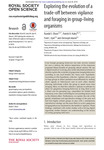Exploring the evolution of a trade off between vigilance and foraging in group living organisms
| dc.contributor.author | Olson, Randal S. | en_US |
| dc.contributor.author | Haley, Patrick B. | en_US |
| dc.contributor.author | Dyer, Fred C. | en_US |
| dc.date.accessioned | 2016-06-25T01:57:28Z | |
| dc.date.available | 2016-06-25T01:57:28Z | |
| dc.date.issued | 2015 | en_US |
| dc.identifier.other | HPU4160271 | en_US |
| dc.identifier.uri | https://lib.hpu.edu.vn/handle/123456789/21776 | en_US |
| dc.description.abstract | Even though grouping behaviour has been actively studied for over a century, the relative importance of the numerous proposed fitness benefits of grouping remain unclear. We use a digital model of evolving prey under simulated predation to directly explore the evolution of gregarious foraging behaviour according to one such benefit, the ‘many eyes’ hypothesis. According to this hypothesis, collective vigilance allows prey in large groups to detect predators more efficiently by making alarm signals or behavioural cues to each other, thereby allowing individuals within the group to spend more time foraging. | en_US |
| dc.format.extent | 12 p. | en_US |
| dc.format.mimetype | application/pdf | en_US |
| dc.language.iso | en | en_US |
| dc.publisher | The Royal Society | en_US |
| dc.subject | Biology | en_US |
| dc.subject | Computational biology | en_US |
| dc.subject | Behaviour | en_US |
| dc.subject | Evolution | en_US |
| dc.subject | Group foraging | en_US |
| dc.subject | Genetic relatedness | en_US |
| dc.subject | Reproductive strategy | en_US |
| dc.title | Exploring the evolution of a trade off between vigilance and foraging in group living organisms | en_US |
| dc.type | Book | en_US |
| dc.size | 548KB | en_US |
| dc.department | Education | en_US |
Files in this item
This item appears in the following Collection(s)
-
Education [806]

